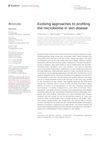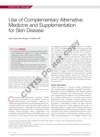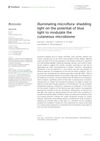The Microbiome in Patients with Atopic Dermatitis
November 2018
in “
Journal of Allergy and Clinical Immunology
”
TLDR People with atopic dermatitis have different skin bacteria, and targeting these bacteria might help treat the condition.
The document reviewed the role of the skin microbiome in atopic dermatitis (AD), highlighting that individuals with AD had a distinct microbial composition, notably increased Staphylococcus aureus colonization, which correlated with disease severity. It emphasized the importance of microbial diversity in maintaining skin health and suggested that targeting the microbiome could be a potential therapeutic strategy. Studies indicated that applying commensal organisms topically could reduce AD severity by decreasing S. aureus colonization. The findings underscored the need for further research into microbiome-based treatments and the impact of early-life microbial exposures on immune system development and disease susceptibility.



